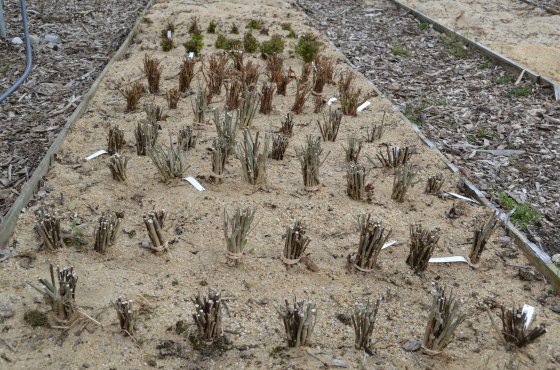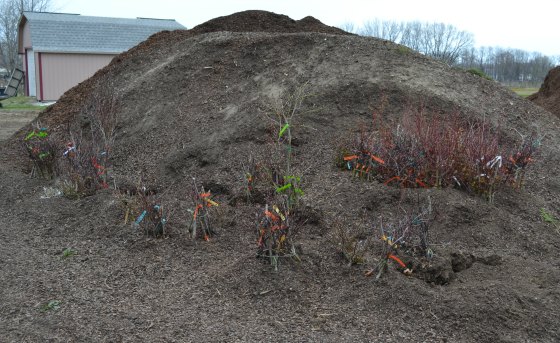
Rooted cuttings heeled in large nursery pots.
Heeling in? What do you mean by that?
I’m telling people that they can temporarily “heel in” plants until they are ready to deal with them and this often confuses people. Why do I need to do that?
There are a lot of reasons for heeling plants in, but the reason that we do it most often is because we have plants that we need to get dug before they break dormancy in the spring. So as soon as the weather permits we get everything dug that we need to dig before the plants make leaves.
Once plants leaf out in the spring, the digging/transplanting season is over. We never mess this up. As soon as spring breaks all we concentrate on is getting things dug that need to be dug. Because once plants make leaves in the spring (usually late April here in Ohio), the digging season is over until after Thanksgiving.
This spring I had thousands of rooted cuttings that I had to dig first thing in the spring but there were so many that we couldn’t get them all potted right away. So we dug them, root pruned them, top pruned them, and heeled them in large nursery pots like you see at the top of this page. They can stay that way for a few weeks until we get caught up.

Rooted cuttings heeled in a bed of sand.
When we ran out of large buckets we just heeled them in the bed of sand where they were originally rooted. You can see them in the above photo labeled and tied in bundles awaiting their turn to be potted.
I also heel in bare root plants that I buy from large wholesale nurseries.
When I buy bare root plants from other wholesale growers I often have them shipped here in February because I want them before they leaf out. That way I can put them outside and not have to worry about them freezing. I simply heel them in the ground, in a pile of soil, or I make a wooden frame that just sits right on top of the ground, put the bare root plants in the frame and cover the roots with potting soil or sand.
On this page, Mike’s Nursery from the Beginning, there’s a video where you can see me pulling Lavender Twist Weeping Redbud Tree from such a frame and putting them in my bright orange wheelbarrow.
Heeling in Japanese Maple Trees

Japanese Maple trees heeled in a pile of potting soil.
This spring Duston and I dug around 100 Japanese maple trees early in the spring. We tied them in bundles and simply buried the roots in My Huge Pile of Potting Soil. All we have to do now is keep them watered until we get them all potted. We’ll probably finish potting them today. I”ll get another photo of them all potted up waiting to be adopted to new homes.
Mike, I’m moving and I want to take my (whatever) tree with me, but I’m not moving for another month!
I get this question a lot and the answer is simple. Dig the tree in the spring before it makes leaves and heel it in until you are ready to move. Keep it watered, but at the same time when a plant is heeled in, you have to know that the plant thinks it is planted and quickly goes to work to establish itself in it’s new home by make roots and trying to anchor those roots into the ground.
So heeling in plants is very much a temporary thing. You can prevent them from rooting into the soil below simply by laying down plastic before you heel in the plant. Just make sure the plastic does not trap water. The water has to be able to run off of the plastic.
Questions or comments? Post them below. And don’t Forget to Support the Donkeys in their Run for the White House!
Hi Mike,
We live in a condo commune and the landscaper decapitated our two Japanese maples , cutting
2 1/2′ off our pride & joy and about 1′ off the other, are they ruined???? We cannot have width, we want height, please advise.
Many thanks,
Rich
Rich,
He certainly did not help them. As they grow you need to select a single leader on each and remove others to gain some of that height back. It should work, just won’t happen fast.
Plan to try hard wood rooting
Plan on trying hard wood rooting
Hi Mike,
I’m getting 100 blue rug juniper liners and want to winter them outside. They are comming in August and I live in Va. What would be the best way to do this? Thank you so much.
Gale,
Either pot them or plant them in a bed. Junipers are pretty tough, just don’t let them dry out over the winter. The ideal thing for pots is to cover them for the winter, but the truth is I don’t cover mine. Some are protected by being a bit below grade but others are at grade, outside uncovered all winter. http://mikesbackyardnursery.com/2013/11/over-wintering-protecting-plants-for-the-winter/
hi mike. im on winter. got with me like 10 japanese maples. all potted. if i take some cutting. can u give me any advice for rotting those cuttings please? i tried only one air layer. not success yet. i mean i waiting to next year for checking.
Louis,
Japanese maples are difficult to grow from cuttings but they can be grown from seed. See our maple site for details. http://japanesemaplelovers.com/
Mike I watched your video about rooting tree cuttings. I’m in SC and the leaves are on the dwarf Japanese maple now in May. Using your bucket in the bag method- how long do I keep the cuttings in the bag before I check for roots? I’m moving and I want to root a few of these trees for my next home.
Pamela,
Usually 4 to 6 weeks then you can check for roots. More here; http://mikesbackyardnursery.com/2015/01/easy-summertime-plant-propagation-techniques-can-home/
Hi I live in ohio I have a fireball hibiscus it’s sprouting now I was wondering when the best time and best method to reproduce it would be
Connie,
Try some cuttings in late June, http://mikesbackyardnursery.com/2015/01/easy-summertime-plant-propagation-techniques-can-home/
Hello Mike!
I am new to your site, and found it looking up how to root lilacs. I have some beautiful white and purple lilacs here in NJ and plan to move up to Maine this fall. I will be vacationing up in Maine in August and plan to plant my cuttings then. I already have old lilacs in my yard there, so i know they will grow. My concern is will they winter over well as young cuttings??
Can I also root cuttings the same way from Rose of Sharon ?
Denise,
Getting young lilacs through the fist winter can be challenging but it’s still wort a try. See this, http://mikesbackyardnursery.com/2015/01/easy-summertime-plant-propagation-techniques-can-home/ The rose of sharon can be done the same way.
Can you plant a Japanese Maple (bloodgood) in zone 5 (southern Wisconsin) – can they tolerate afternoon sun?
Bob,
Most Japanese maples are rated down to zone 5. They’d love afternoon sun.
Mike,
I live in the Sierra Nevada (Lake Tahoe). I read your comment “Once plants leaf out in the spring, the digging/transplanting season is over.” The problem I encounter is the spring arrives here and we still get snow through May and sometimes into June. Plants are coming up and making leaves, but planting too early leaves new plants to be frozen out. By the end of October, it is snowing again, most years. This leaves me with a limited window of opportunity to do ALL of my gardening. What would your planting/transplanting strategy be in my situation? I have plants that I want to divide and transplant, but they are already green, and they are predicting snow for this weekend.
Bil,
Our situation isn’t a lot different. I have to schedule all of my digging and transplanting for the first task in the spring. It all has to be done in about two weeks then we move onto to other things.
Mike; please tell how to plant japenese weeping maple like what to put into hole and anything else we need to use. thank you.
Connie,
Keep it simple, no additives, just dig a hole and plant the tree. Do not plant it too deep, no deeper than how it was in the pot or the ball, actually about an inch and half higher is good. Don’t plant it in a wet area, do not over water it and no fertilizer.
Do you have any of the Rainbow’s End plants!
Benita,
No I don’t, don’t really know what it is.